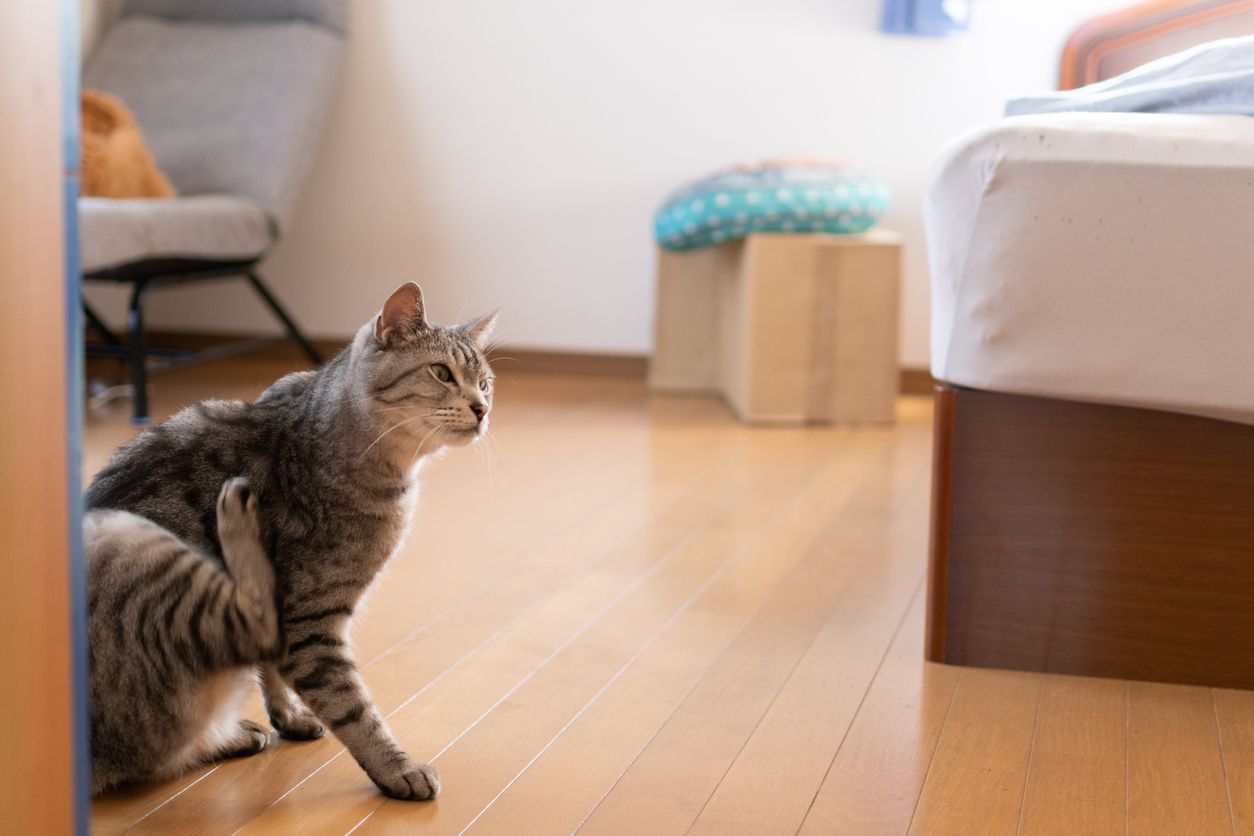What to do if your cat has dandruff or dry skin

Disclaimer: This article and its content and related references does not constitute veterinary advice and should not be considered a substitute for veterinary care.
Dry skin and dandruff are often overlooked by pet parents as these concerns are rarely of great concern in human health. In fact, flaky skin and dandruff are often signs of an underlying medical concern in cats. Even mild dandruff or flakes in the fur might warrant a review with a veterinarian. If you have a cat, read on to learn:
- How do I know if my cat has dandruff?
- Can I treat my cat’s flaky skin?
- Why does my cat have dandruff?
- Can cat dandruff be prevented?
- What do I do if my cat has dandruff?
Dandruff in cats is usually a sign that something else is going on that needs to be addressed. While human dandruff is not usually a significant medical concern, feline dandruff typically results from a disease such as ringworm, mites, or allergies. Once the underlying condition is successfully eliminated, feline dandruff is expected to go away. It’s important to talk to a vet any time you notice a change in your cat’s skin health to determine the cause and get advice on effective treatment.
What is feline dandruff?
Feline dandruff is a symptom characterized by white flakes on the skin and in a cat’s fur. Dandruff is not a skin condition itself and can be caused by a wide variety of other medical conditions or specific situations. Dandruff in cats can occur with dry skin or overly oily skin, depending on its underlying cause.
What does cat dandruff look like?
Dandruff refers to the white flakes found in a cat’s fur and on the skin. Other than flakes of dandruff, a cat may experience other symptoms, such as:
- Overly oily or dry skin
- Hair loss
- Itchy skin
- Skin irritation and inflammation
- Skin sores
- Rash
It’s important to consult with a vet any time you notice changes in your cat’s skin or coat. Feline skin issues are almost always caused by an underlying problem that needs to be addressed and treated by a veterinarian.
How can I help my cat’s flaky skin?
Dandruff and flaky skin in cats can be caused by a number of factors ranging from harmless to severe. It’s difficult to know what is causing a cat’s flaky skin without help from a vet. Symptomatic cat dandruff treatments such as fish oil supplements, special shampoos, or topical treatments should only be used when directed by a veterinarian. Note: It's not safe to use human dandruff shampoo on pets unless otherwise instructed by a veterinarian, as these products contain medications and other additives that can be toxic to pets. Always consult a veterinarian before using medications on pets.
Use year-round flea control products
Broad-spectrum flea control products help prevent external parasites that can cause dandruff, itchiness, and skin inflammation, such as:
Cats can be allergic to flea saliva, resulting in flea allergy dermatitis when they are bitten. This condition results in excessive itchiness and inflammation as well as an increased risk of secondary skin infections.
Treat other medical conditions and skin infections
Underlying conditions and skin infections can cause dry, flaky, and irritated skin. Treatments vary depending on the condition that is diagnosed. Treatments may include:
- Parasite treatment and prevention
- Diet change
- Weight management
- Antibiotics or antifungal medications
- Medicated shampoos
- Dietary supplements
- Allergy treatments
- Arthritis treatment and management
- Ongoing treatment for other health issues
A veterinarian can help diagnose and treat these underlying medical conditions appropriately. Some conditions, such as allergies, require long-term treatment plans to keep the symptoms in check.
Groom your cat regularly
Regular grooming with brushes and combs helps distribute healthy oils to keep the skin healthy and moisturized. Brushing also helps remove buildup of dead skin cells that can flake off into the fur. Cats with mobility issues from arthritis, obesity, or injuries often need help grooming in hard-to-reach areas such as the lower back. In addition, matted fur or a buildup of the undercoat can trap shedding skin, resulting in irritation and flakiness. This can occur in both short and long-haired cats. If your cat requires bathing, avoid harsh shampoos and overly hot water. Remember to always thoroughly rinse the shampoo from the coat. A professional groomer or vet can help you choose the best products and bathing practices for your individual cat’s needs.
Invest in an air humidifier
Dry environments and the winter season can contribute to skin dryness in both cats and people. Investing in an air humidifier for your home may help with mild dry skin and dandruff. If your cat is showing other symptoms or severe dandruff, they most likely have another underlying cause and need to see a veterinarian.
Talk to a vet about diet and supplements
A balanced diet for a cat includes fatty acids and other essential nutrients to keep their skin and coat healthy. As a result, a poor diet can result in poor skin and coat health. Most commercial cat foods have enough fatty acids for the average cat. However, cats with specific conditions may require a special diet or supplements. Omega-3 fatty acid supplements are often part of the treatment plan for conditions that cause dry skin, but may not be necessary in your situation. Talk to a vet to learn more about choosing an effective or appropriate supplement in a nutrition consultation.
What is causing my cat’s dandruff?
“Most of the time when a cat has dandruff, it’s due to an underlying condition and the dandruff goes away once that’s successfully treated,” explains Dr. Jo Myers, a Vetster veterinarian. “Diagnosing skin conditions can be complicated because they all look alike, so talk to a vet to learn more about what might be causing your cat’s dandruff.”

Some causes of dandruff are easily treated. Others are more difficult to diagnose and may require continuous care. A vet may recommend diagnostic tests such as skin scrapes and blood tests to determine the cause of your cat’s dandruff.
Environmental or food allergies
Fleas, ingredients in food, or pollen and other environmental allergens can cause allergic skin reactions in cats. Allergies in cats can flare up seasonally or be a year-round challenge for pet parents. Work with a veterinarian to find the best way to treat your cat’s allergies. Allergies cannot be cured but are instead managed long-term.
Parasites and other health conditions
External parasites, skin infections, and other medical conditions can affect skin health. Different conditions require varying diagnostic tests and treatments. These conditions include, but are not limited to:
- Ringworm and other fungal infections
- Bacterial skin infections
- Obesity
- Osteoarthritis
- Cushing’s disease
- Hyperthyroidism
- Diabetes
- Skin cancer
Regular wellness checks and testing can help catch many of these conditions early to provide treatment before they severely affect the skin.
Difficulty grooming
Healthy cats groom regularly to distribute oils in the skin, remove dead skin cells, and comb through the fur. Cats with mobility problems cannot successfully reach their entire body, resulting in a buildup of skin cells, dry skin, and matted fur.
Dry air
Dry climates or dry winter air can cause mild dandruff and dry skin in cats. Using an air humidifier can help. Talk to a vet or groomer about other products that may help your cat’s mild dry skin that may be related to lack of humidity in their environment.
Does water intake affect a cat’s skin health?
Healthy cats naturally drink enough water to stay hydrated and keep their skin in tip-top shape. Cats who are chronically dehydrated due to an underlying medical condition may have poor skin health as one of their symptoms. Don’t assume your cat’s dry skin is the result of not drinking enough. Instead, work with a veterinarian to address the underlying cause.
Can I prevent dry, flaky skin in my cat?
Feline dandruff is usually caused by an underlying factor such as a skin infection, allergies, or improper grooming practices. Veterinary attention is needed any time you notice a change in your cat’s skin or coat to determine the underlying cause. You can help prevent dandruff and promote healthy skin in your cat by:
- Getting routine wellness checks with a vet
- Use year-round flea and tick prevention
- Feed a nutritionally complete diet
- Keep your cat at a healthy weight
- Brush and groom your cat regularly
- Talk to a groomer or vet if bathing is needed
- Increase humidity in your home with a humidifier
Many skin issues in cats can be prevented with routine wellness checks, daily brushing, a well-balanced diet, and preventing parasites with monthly flea and tick prevention.
What should I do if I see white flakes in my cat’s fur?
Since there are so many potential causes of unhealthy skin in cats, a check-in with a vet is necessary, even with a seemingly benign symptom like dandruff. If you notice a dandruff issue on your cat, check to ensure their food is nutritionally complete and their parasite control is up to date. Check for other symptoms such as:
- Skin lesions, sores, or rash
- Itchiness
- The presence of parasites in the fur or on the skin
- Other signs of illness, such as vomiting or diarrhea
Even if your cat isn’t showing additional symptoms, it’s important to talk to a vet promptly and make a plan to identify and treat the underlying cause of your cat’s skin problem. Follow your veterinarian’s treatment plan, including all instructions related to:
- Medications for underlying medical issues
- Daily brushing
- Using a humidifier
- Giving fish oil or omega-3 fatty acid supplements
- Changing food
- Using special shampoos, conditioners, or other coat treatments
If you notice that your cat’s skin is dry, inflamed, or flaky, you can talk to an online vet in your area to get advice on testing and treatment.
FAQ - How to get rid of cat dandruff and flaky skin
What can you do for dandruff on a cat?
Mild dandruff may benefit from gentle brushing or bathing, but if that doesn’t help or if your cat is showing other signs of skin problems or illness, veterinary attention is required. Dandruff and flaky skin in cats are almost always caused by an underlying condition that needs medical treatment.
Should I bathe my cat if they have dandruff?
It’s best to use dandruff shampoos and other at-home treatments only when recommended by a veterinarian. Skin issues in cats, including dandruff, can be caused by a wide variety of health issues. It is possible that bathing a cat with dandruff can make the dandruff worse while the underlying cause may continue to progress.
Does brushing help a cat with dandruff?
Brushing can help with mild dandruff in cats by distributing natural skin oils, removing dead skin cells, and detangling the fur. Fur matting and undercoat buildup can also pull at the skin, causing dry, flaky, or inflamed skin underneath. Cats with mobility issues may also need additional help grooming if they cannot fully groom themselves. Brushing is often part of the treatment plan, but cats usually need specific intervention for the underlying condition that caused the dandruff in the first place such as parasite control or allergy medication.
Does wet food help with cat dandruff?
Dehydration does not cause dandruff in cats, so increasing water consumption with wet food will likely not help. Seek veterinary care any time your cat shows signs of unhealthy skin, as it is almost always caused by an underlying medical condition or a result of poor grooming practices.




